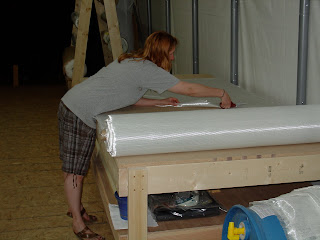We spent the week prepping to laminate the interior layer of glass in the first float hull half. To make the process go smoother, we cut all the glass fabric ahead of time. We were careful to number or mark each piece of fabric so we could keep track. Here you see lovely Dawna cutting a piece of 12 oz bi-directional fabric. The direction of the glass fiber bundles (warps) is critical in optimizing the strength of the structure with minimal material. We also cut some unidirectional glass reinforcing, and peel-ply. The peel-ply is normally used for vacuum lay up (coming soon to our boat house), but can also be used with hand wet out lamination to produce a better finished surface. The peel ply is a nylon fabric treated so the epoxy will not strongly adhere to it. After the epoxy cures, we can peel it off (hence the name).
Here is a piece of glass fabric being dry fit to ensure we have enough excess to allow positioning when time is running out. After cutting all the glass fabric, we fabricated a reinforcing stringer out of foam (see photos below), marked the interior for easier placement of the reinforcing layers and bulkheads, and then did a final sanding to remove any shine from the previous epoxy skim coat. We were careful to not touch the surface after sanding without gloves on to avoid getting skin oil on the surface, which could inhibit good bonding (even more than our poor technique).
On Friday we were ready to start laminating. Here is Dawna again, hard at work wetting out the BD glass. This is working out nicely, Dawna does the hard work while I take pictures! After the first two sections of fabric were wet out, and the peel ply was applied, we came to the conclusion that glassing concave surfaces is a pain in the butt. It takes some patience and practice to get the glass wetted without shifting it and producing gaps between the fabric and foam. Of course, by the time we really got the rhythm of the process, the temperature in the boat house was in the nineties. This is not exactly ideal conditions for working with epoxy, but the slow set MAS epoxy still gave us about 30 minutes of working time before it started to gel. It took us about 3 hours to do all of the laminating for the interior, including extra layers where the bulkheads will be installed and installing the foam core for the stringer. I had to finish the lamination of the stringer and a couple extra layers of reinforcing on Saturday, but that only took about 1.5 hours by myself.
And here is the finished product with the future happy sailor standing by. I am pretty satisfied with the way it turned out. I am sure we have not optimized the resin to glass ratio, but we tried to only apply enough resin to saturate the glass fibers.
You may note that I still have to trim the edges, an easy task with a sharp knife. You might also note that we only used the peel ply for the two stern sections. It was adding too much time and effort to justify for the interior of a float. We decided to use this as an opportunity to compare the two surfaces.
Conclusion:
peel ply = smooth, with very fine texture
no peel ply = rough with the texture of the glass
I think the peel ply will be very nice for the exterior and the main hull where final texture really matters.
Here you can see the reinforcing stringer glassed onto the forward third of the side of the hull. The foam core was bonded to the hull with a mix of epoxy and microballoons. The primary strength of the stringer comes from a layer of unidirectional glass along it's length. This is then overlaid with a layer of BD glass to bond it all together and to complete the box beam design of the stringer.
Next steps are to make the bulkheads and install them. Then we can remove this half and start the next. Ah, the scent of progress (actually progress smells a lot like stinky arm pits!)
Subscribe to:
Post Comments (Atom)





I was excited to uncover this great site. I wanted
ReplyDeleteto thank you for ones time due to this fantastic read!! I definitely enjoyed every bit of it and i also have you bookmarked to
look at new stuff on your web site.
Also see my webpage :: Stofzuigen